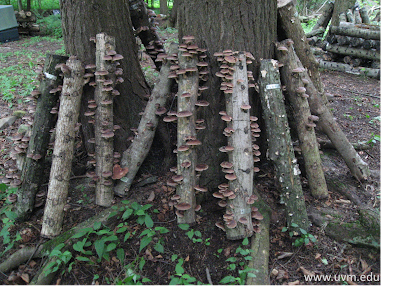When searching for the perfect Christmas tree at the
nursery, be sure to select a tree that serves your function, but especially one
that is healthy and well watered. Often times, Christmas trees will lose their needles
early, and all of the hard work put into decorating this tree are wasted. This
document will cover the history of Christmas tree and some basic tips on
selection and maintenance.
History
Even before Christianity, evergreen plants, like fir, spruce
and pine, were used to decorate houses in the winter to ward off illness,
witches, ghosts and evil spirits. The shortest day of the year meaning the day
with the least amount of sunlight, also called the Winter Solstice, usually
falls on December 21. Many ancient
peoples believed that the sun was a god and that when the days began to get
shorter the sun god was getting sick and tired. They celebrated the Winter
Solstice because they saw a glimmer of hope for the healing of this god after
this day. During the solstice, evergreen boughs would be hung, reminding them
that the sun god would regain strength and summer would return again. Between
the Egyptians paying homage to Ra by filling their homes with green palm
rushes, symbolizing the triumph of life over death, or the Vikings thinking
evergreen plants were special plants for the sun god Balder, this tradition of
decorating our homes with evergreen trees or plant parts is ancient.
Germany is accredited with starting the Christmas tree
tradition as we know it today in the 16th century. Martin Luther, 16th
century Protestant reformer, is credited with the first idea of adding lights
to a Christmas tree. After staring at the twinkling stars on the horizon one
evening, he came up with the idea of bringing in the cold, beautiful dancing
sky hovering above the snow covered evergreens into his home by placing small
candles in wires on his tree.
In the 1840s in the first colonies, the Christmas tree lost
its appeal and was seen as a pagan symbol and not accepted by most Americans.
In fact William Bradford, the pilgrim’s second governor, wrote that he tried to
stamp out “pagan mockery” of the observance, penalizing any frivolity. The
pilgrims noted that Christmas was a sacred holiday, and the general court of
Massachusetts enacted a law making any observance of December 25 (other than
attending church) a penal defense.
It wasn’t until Queen Victoria and her family was sketched
in an illustration in the London News standing next to a decorated Christmas
tree that the Americans continued their past Christian tradition, which is the
decorating of Christmas trees as we know it today.
Tree Selection and
Maintenance
When browsing the nursery or field for the best tree, look
for trees that look green and healthy. Healthy Christmas trees will have no
brown needles and branches will be tough and not fall off very easily. You will
also want to choose the right size tree for the space you will keep it. For
this, you should measure your ceiling space, and determine the size of the
designated area where your tree will be displayed.
Once the tree is brought home, it should be placed in water
immediately. If you will not be putting it up for display, immediately, keep it
in a warm place like a garage for best shelf life. A fresh cut about a quarter
of an inch from the base should be made in the newly purchased tree when you
are ready to erect it in the stand. This is so the water can be most
efficiently delivered through the vascular tissues of the plant. One thing to
note is the larger the diameter of the Christmas tree, the larger amount of
water it will need through the course of the holiday season. In fact, a general
rule of thumb is the tree stand should hold a quart of water for every inch in
diameter of the trunk of the tree. This means for a tree that has a trunk of 4
inches in diameter, you will need a stand that holds a gallon of water at any
point in time. This could help you in the selection of the size of the tree or
the type of tree stand that you will be purchasing.
Old wives tales teach of different amendments, such as
vodka, 7-Up, bleach and sugar, that can be added to the water to increase the
longevity of the green needles on your Christmas tree, but in actuality clean,
cold water is all that is needed. In fact, some amendments used as “additives”
can cause premature needle drop.
Through the season, be overly cautious about making sure the
tree doesn’t dry out, because this is the only parameter that will impact the
longevity of your beautiful Christmas tree. Do this by checking the clean water
once daily and refilling as needed. This will insure you that your tree is
using water, and as a result remaining green. Another tip is to use lights that
are more efficient than our traditional large, incandescent light bulbs. LED
lights are a good replacement for our old incandescent lights because they are
not as hot (keeping the tree drier), and they use 90 times less the amount of
energy to run, saving your pocket book some real dollars.
Keep the tradition and your Christmas trees alive during
your holiday season. Merry Christmas and Happy Holidays to all of my readers.
















































.jpg)